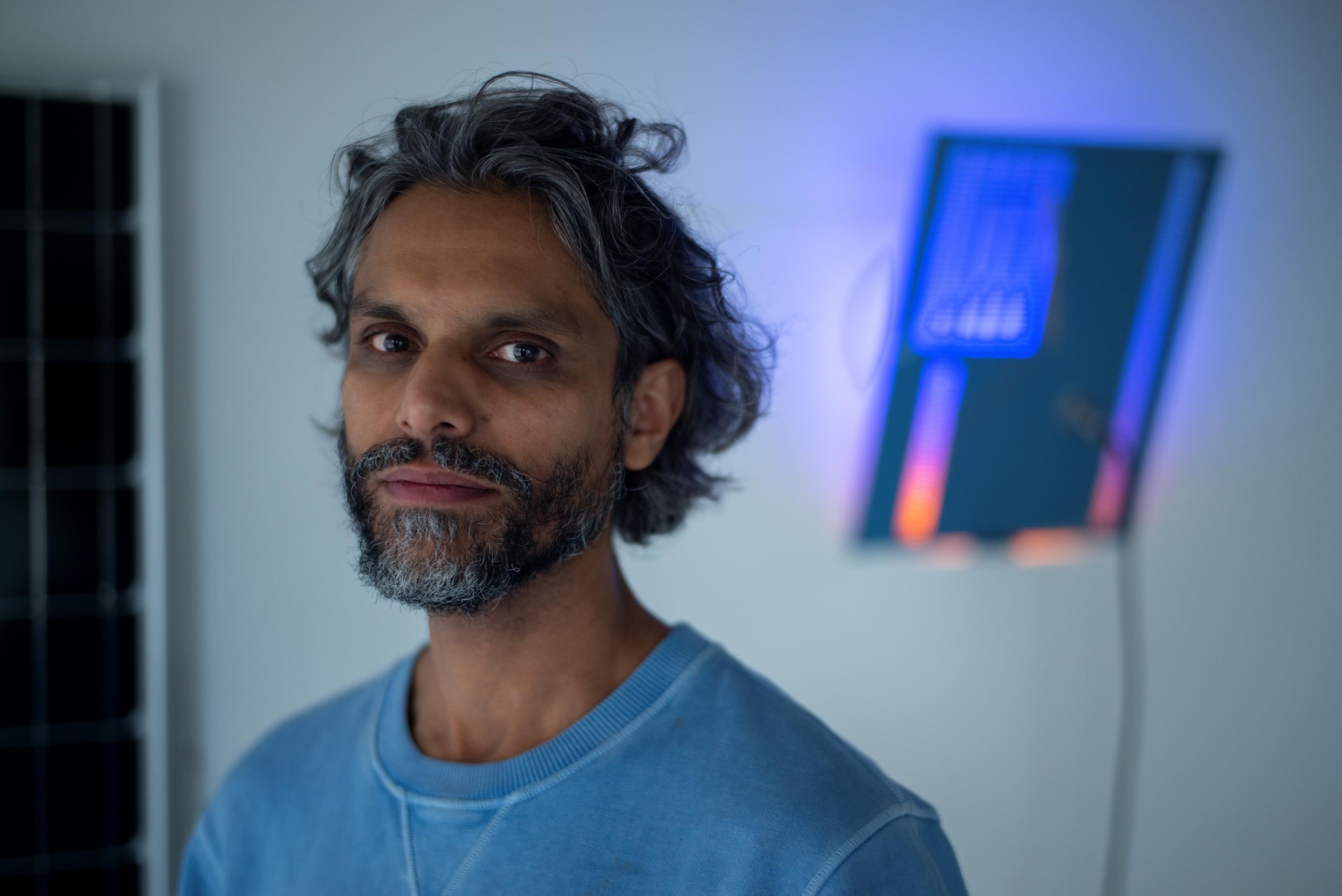Haroon Mirza, a leading figure in contemporary art, was born in London in 1977, where he lives and works.
Alice Audouin: How and when did you start integrating solar energy in your work ?
Haroon Mirza:I fell into it by accident! I had to set up an installation at Villa Savoye, a space where using the mains electricity wasn’t an option, so I used solar energy as a solution. Following this experience, I started using photovoltaic panels as both an energy source and a sculptural element – the medium allows me to reflect on the technological and symbolic place of the sun in a post-carbon future. Electricity has become my primary means of expression.
You look at solar energy from an anthropological point of view. How would this energy change society if it was expanded?
Solar energy is a far more ecologically friendly energy solution than fossil fuels, with the further benefit of enabling us to feel more connected to our environment. People can see the energy source in the sky above their heads just like they can see solar panels around them, so they intuitively understand how it works, as opposed to a method like fracking, where much of the process and energy source is hidden. This increased connection to natural elements and the cosmos is a good start to having a more balanced relationship with the planet and reducing our addiction to consumption. Moreover, seeing what this star provides us inspires gratitude, which is part of what I try to achieve with my work – to create rituals that help us to worship nature as we should.
You have a strong knowledge on recent energy research and technologies. What is your relationship to science?
Yes, I am also fascinated by solar energy from a scientific perspective. My personal interest in energy research and technology shows me just how difficult the environmental challenge is, both technically and technologically. I am currently excited by condensed matter research developing superconducting materials at normal temperatures, which would allow solar energy to be exponentially more efficient. If we achieve that, one huge solar farm could provide energy to an entire country. However, until then, we cannot consider solar energy as a sustainable global solution that could completely replace oil or even nuclear energy. So, while my work is poetic, it comes from a long scientific and technological research process.
You participate in several exhibitions in the Middle East. Is it a region that attracts you specifically?
The Middle East is a fascinating place, which invests a lot in arts and culture. Their aspiration is to host the best galleries, museums, art schools and institutions within an environment at the front line of climate change. These are cultures emerging from the desert, so traditionally they have wisdom on how to deal with extreme climate, but the West very much inspires their desired way of living. So worryingly, instead of finding solutions from that history, or reducing oil consumption, there is 24/7 air conditioning and gas-guzzling vehicles. That said, I am sure this mindset will change very soon and my goal in many ways is to contribute to increasing awareness.
Currently, I’m participating in the Islamic Arts Biennale AWWAL BAIT, which just opened in Jeddah, Saudi Arabia, as well as the Noor Riyadh art and light festival’s group show “From Spare to Spirit” and the Ishara Foundation’s “Notions on Time” exhibition in Dubai. At the end of February, my work “Dyson Sphere”, initially designed for the “Novacène” exhibition in Lille in 2022, will also be exhibited in the new group show “The Only Constant”, at the New York University Abu Dhabi. I am delighted to bring this piece to this place where the sun is so overwhelming.
Could you tell us more about Dyson Sphere?
Dyson Sphere is based on the concept of the Dyson Sphere imagined in 1960 by scientist Freeman Dyson – A megastructure capable of surrounding the sun or a star to harness its energy. The Dyson Sphere is a direct testament to our obsession with technological progress and hubris. The work asks a philosophical question to our specie in the face of climate and energy issues: are we a parasitic specie that absorbs all the resources of a planet? Or do we want to live in symbiosis with the rest of nature and the biosphere? This dystopian threat invites us to choose utopia: that of a world where solar energy becomes a source of both conviviality and sobriety.
Regarding energy sources, what can we do to accelerate the ecological transition?
The present system is energetically inefficient. Birds are efficient, cars are not. Humans on bicycles, however, are far more efficient than driving cars manufactured using extensive energy. Humans have a greater impact on energy efficiency than technology. A few technologies enhance human efficiency but most do not.
Following your solo exhibition in Max Goelitz’s new gallery in Berlin, you will open another solo exhibition at Lisson Gallery in London on the 24th of February. What does its title mean, “III”?
I will present installations around the frequency of 111 Hz, which has numerous meditative as well as therapeutic and healing effects and was thus used in ancient rituals. I am using both synthesizers and traditional instruments, such as a Tibetan singing bowl and a bespoke harmonium from India known as a Shruti box. It is not the first time that I have been inspired by this phenomenon : I staged my work “MindFlip” during 111 hours for the Frieze Live program in 2020! This show will gather sound, plants, ants, and solar panels, in a highly connected dialogue with our spirits.
In conversation with Alice Audouin

